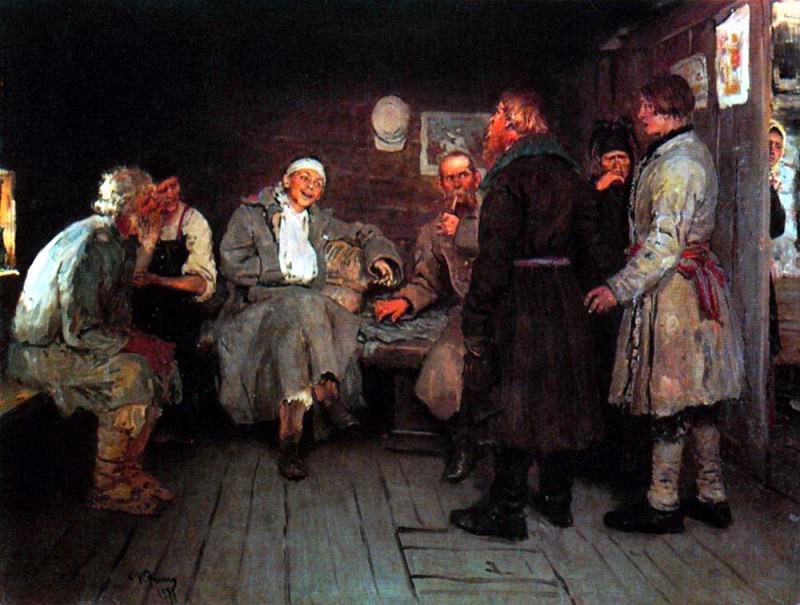Returning from the war Ilya Repin (1844-1930)
Ilya Repin – Returning from the war
Edit attribution
Download full size: 1000×756 px (0,1 Mb)
Painter: Ilya Repin
Location: Kadriorg Palace, Tallinn.
The author of many world-famous paintings, Russian genius Ilya Repin created another masterpiece of genre painting in 1877. The work is called "Returning from War". It presents the viewer a multi-figure composition with deep social implications. The central figure - a young soldier, with a big smile and cheerfulness telling his astonished listeners in the village war stories. One can notice the author’s ironic and even denunciatory attitude to the soldier’s behavior in the painting.
Description of Ilya Repin’s painting "Return from the War".
The author of many world-famous paintings, Russian genius Ilya Repin created another masterpiece of genre painting in 1877. The work is called "Returning from War". It presents the viewer a multi-figure composition with deep social implications.
The central figure - a young soldier, with a big smile and cheerfulness telling his astonished listeners in the village war stories.
One can notice the author’s ironic and even denunciatory attitude to the soldier’s behavior in the painting. The boy returned to his native village with a slight wound: his forehead is bandaged and his right hand is tied to his neck. His relaxed, self-satisfied demeanor makes the villagers shy.
The soldier’s tales upset the women in the cabin. The men react in different ways: a young man opens his mouth in surprise, mature and elderly men listen with interest. A severe-looking mustached man even lit a cigarette. You just want to be a participant in the scene, to hear the story that has so alarmed everyone.
Repin painted historical domestic paintings in the style of realism. Simple, untidy clothes of the people reliably convey the state of the people in the postwar period. The decoration of the hut is modest and gloomy. But the bright emotions of joy and liveliness of the people gathered here distract attention from the inconspicuous surroundings, painting the atmosphere of the canvas with bright colors.
In the far corner, a woman in black attire seems to be hiding. She is not attracted to what is happening in the house. The mother or someone’s wife is imbued with grief - she mourns the dead, those who have not returned like this joyful soldier.
The Russian painter again struck with his mastery of creating a genre scene where all the characters wear individual traits and are consumed by different feelings.
"Return from the War" is in the Estonian Metropolitan Museum of Art.
Кому понравилось
Пожалуйста, подождите
На эту операцию может потребоваться несколько секунд.
Информация появится в новом окне,
если открытие новых окон не запрещено в настройках вашего браузера.
You need to login
Для работы с коллекциями – пожалуйста, войдите в аккаунт (open in new window).




















COMMENTS: 1 Ответы
Весельчак. Будучи раненым он все равно рассказывает фронтовые подвиги.
You cannot comment Why?
In the center, a woman with a bandage around her head and arm is seated, her face alight with a broad, perhaps unsettling, smile and open mouth, as if mid-sentence or burst of laughter. To her left, an older man with a disheveled appearance leans in, seemingly listening intently or engaged in a hushed conversation. Another figure, partially obscured, sits behind him.
To the right, a bearded man with a pipe in his mouth is turned towards the center, his gaze seemingly directed at the assembled group. Beside him, a younger man in a traditional light-colored tunic, adorned with a red sash, stands attentively. Behind them, a woman with a somber expression is partially visible. In the background, hints of other figures and elements, such as what appear to be framed pictures on the wall, suggest a lived-in space. The floorboards are worn, and the overall impression is one of a communal gathering in a simple, rustic setting.
The title, Returning from the War, provides a crucial layer of subtext. The woman in the center, with her bandaged injuries and animated expression, could be a soldier herself, or perhaps a civilian whose life has been profoundly impacted by the conflict. Her cheerful demeanor, despite evident injuries, might suggest resilience, relief at survival, or even a touch of delirium. The varied ages and expressions of the people around her imply a sharing of experiences, perhaps recounting tales of the war, or discussing its aftermath. The painting evokes themes of homecoming, the physical and emotional toll of conflict, community support, and the complex range of human emotions that emerge in the wake of hardship. The contrast between the apparent cheerfulness of the injured woman and the more muted or contemplative expressions of others hints at the multifaceted nature of shared trauma and recovery.